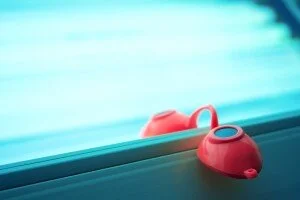Are Tanning Beds Dangerous?
Winter is upon us, and so is the season of taking tropical vacations for some, while others of us just want to look as if we have been somewhere warm and sunny. And, for years now a tan has been the sign of health and vitality.
In the 1920s, people didn’t know about the dangers of ultraviolet (UV) radiation any more that they knew about the dangers of smoking. We are in a battle with the culture of our society about the dangers of sun damage to our skin.
Tanning salons are big business in the U.S., with nearly 30 million people a day who are baking themselves under tanning lamps. More than 70% of them are Caucasian females ages 16-49 years. The tanning industry’s revenues have increased to about $5 billion dollars a year since 1992. They are making big money selling a known carcinogen.
The rays from tanning bed bulbs consist of two types of UV radiation:UVA and UVB.
UVA rays are longer than UVB rays and penetrate deeper into the layers of skin. Both types of rays cause damage to the immune system, DNA damage, and premature aging and wrinkling. They cause all types of skin cancer: basal cell, squamous cell, and the deadliest form, melanoma. UVB rays are shorter, producing quick sunburns. Tanning salons frequently advertise their bulbs as having more UVA rays, which they say are safer than UVB rays. The UVA rays are indeed NOT safer—they just don’t produce a burn as quickly as UVB rays.
Many times, tanning salons lure you in with “healthy” promises. For instance, some claim that tanning is necessary to obtain sufficient quantities of vitamin D or to help prevent osteoporosis. Taking a vitamin D supplement is far safer! For those who are avid tanners, those “unlimited tanning sessions” packages can be hard to resist, especially when it’s cold and dreary outside. And, if you are trying to arrest a case of Seasonal Affective Disorder, don’t go for the tanning bed. There are specially-made lights that can help with this problem (see my blog about SAD).
There is no such thing as a “safe” tan. When our skin is exposed to ultraviolet rays of the sun or tanning beds, the production of the pigment called melanin starts, and it darkens the skin, producing a tan. But by this time, damage has already occurred. The tan is your body’s response to skin damage. You can see this damage in people who have been exposed to the sun, unprotected, for years. Many more wrinkles and discolorations are evident, giving an appearance of the person being much older than they really are!
According to the melanoma foundation, using tanning beds just once a month increases the risk of getting melanoma by 75%. Twenty minutes in a tanning bed equals up to 3 unprotected hours in direct sunlight and can cause a severe sunburn.
Unfortunately, skin aging, damage, and skin cancer are the delayed effects that usually come to surface after many years. Since the damage is not immediately apparent, those in their teen years are often unaware of the dangers of tanning.
Teens are especially at risk because their bodies are growing rapidly, making their skin cells more prone to the damage of the UV radiation. Teens who tan regularly are putting themselves at a greater lifetime risk of developing skin cancer.
Although the World Health Organization (WHO) has called for teens to be banned from indoor tanning due to the dangers, only half of the states in the U.S. regulate tanning bed use by teens. It is up to parents and health professionals to educate children about proper sun protection and the dangers of tanning beds.
Pale skin can be lovely, but if you just must have a tan, then consider a safe, fake tan from a bottle!
There are a few steps to take in order to perfect your look:
Choose a product that you like: sprays, lotions, gels, or mousse. I personally like Jergens Natural Glow foam. It is easy to apply and, as the container says, it “gradually creates natural-looking color, dries in seconds, and has no sunless tanner odor”.
Prepare your skin by exfoliating, that is, removing an even layer of dead skin cells so that you can start with smooth skin. The best way to exfoliate for self-tanning is just by using a firmly-applied cotton washcloth. Skip the gritty bath products.
Blend! Start by applying regular skin lotion to knees, elbows, feet, ankles, hands, and any area with fine lines that might collect excess tanning product. This will help to prevent dark blotches. Then apply the tanner, working in a circular motion to avoid streaks and rubbing downward toward ankles and wrists.
Watch your hands. Wash your hands thoroughly every few minutes or wear tightly-fitting gloves. Then lightly apply the product to the backs of your hands.
Be good to your skin and guard your health!! It’s time to accept the skin color that God gave you!
Blessings to you in the New Year!

